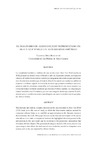Identificador persistente para citar o vincular este elemento:
https://accedacris.ulpgc.es/handle/10553/6425
| DC Field | Value | Language |
|---|---|---|
| dc.contributor.author | Díaz Betancor, Yazmina | en_US |
| dc.date.accessioned | 2011-09-29T02:31:00Z | - |
| dc.date.accessioned | 2018-03-08T09:03:28Z | - |
| dc.date.available | 2011-09-29T04:00:36Z | - |
| dc.date.available | 2018-03-08T09:03:28Z | - |
| dc.date.issued | 2006 | en_US |
| dc.identifier.issn | 1136-3169 | en_US |
| dc.identifier.uri | https://accedacris.ulpgc.es/handle/10553/6425 | - |
| dc.description.abstract | La complejidad temática y estilística de una novela como Brave New World (escrita en 1932) propicia un estudio como el llevado a cabo en el presente artículo, en el que nos valemos del análisis lexicométrico asistido por programas informáticos para aproximarnos a la estructura temática que domina la obra. Se ha optado por centrar en análisis en el primer y el último capítulo de la novela, de modo que podamos establecer una comparación entre los elementos destacables en la presentación de este nuevo mundo y su evolución hasta el ambiente pesimista que domina el último capítulo. La categoría gramatical estudiada será el sustantivo, por ser una categoría abierta que permite la inclusión de nuevos vocablos necesarios para designar una nueva sociedad como la que plantea Aldous Huxley. | en_US |
| dc.description.abstract | The thematic and stylistic complex structure as the one presented in Brave New World (1932) leads us to this sort of study, in which the lexicometric analysis assisted by computer software helps us to establish an approximation to the thematic structure that dominates the work. This paper focuses on the first and last chapter of the novel, what allows us to make a comparison between the highlighted elements present in the introduction to this new world and its evolution to the pessimistic atmosphere that dominates the last chapter. The grammatical category studied is the noun, since it is an open category that allows the inclusion of new vocabulary needed to designate a new society such as the one depicted by Aldous Huxley. | en_US |
| dc.format | application/pdf | es |
| dc.language | spa | en_US |
| dc.relation.ispartof | Philologica canariensia | en_US |
| dc.source | Philologica Canariensia. Las Palmas de Gran Canaria: Facultad de Filología de la Universidad de Las Palmas de Gran Canaria, 1994-.-- ISSN 1136-3169.-- n. 12-13 (2006-2007), p. 363 | en_US |
| dc.subject | 550510 Filología | en_US |
| dc.subject | 570107 Lengua y literatura | en_US |
| dc.title | El imaginario de Aldous Huxley representado en Brave new world: un análisis lexicométrico | en_US |
| dc.type | info:eu-repo/semantics/article | en_US |
| dc.type | Article | en_US |
| dc.compliance.driver | 1 | es |
| dc.identifier.absysnet | 234349 | - |
| dc.identifier.crisid | - | - |
| dc.investigacion | Artes y Humanidades | en_US |
| dc.rights.accessrights | info:eu-repo/semantics/openAccess | es |
| dc.type2 | Artículo | en_US |
| dc.identifier.external | - | - |
| dc.identifier.ulpgc | Sí | es |
| dc.description.esci | ESCI | |
| dc.description.erihplus | ERIH PLUS | |
| item.fulltext | Con texto completo | - |
| item.grantfulltext | open | - |
| crisitem.author.dept | GIR IATEXT: Variación y Cambio Lingüístico | - |
| crisitem.author.dept | IU de Análisis y Aplicaciones Textuales | - |
| crisitem.author.parentorg | IU de Análisis y Aplicaciones Textuales | - |
| crisitem.author.fullName | Díaz Betancor,Yazmina | - |
| Appears in Collections: | Philol. Canar. n.012-13, 2006-2007 Artículos | |
Page view(s)
145
checked on Feb 17, 2024
Download(s)
202
checked on Feb 17, 2024
Google ScholarTM
Check
Share
Export metadata
Items in accedaCRIS are protected by copyright, with all rights reserved, unless otherwise indicated.
